
 |
 |
 |
 |
 |
 |
 |
 |
Interbike show
Las Vegas, USA, September 26-30, 2005
Main Page Previous Part Next Part
Part 25 - An Interbike 'best of'
With the US' biggest bike show becoming a fading memory for another year, James Huang picks his three personal favourites from Interbike 2005.
Best showpiece
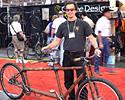
|
Craig Calfee largely stole the show last year with his bamboo and carbon fiber Calfee frames but he outdid himself this year times ten. I know, I know, I can hear it now: “Bamboo? Huh?” Look it up in your engineering textbooks, kids. For its weight, bamboo is really not that far off carbon composites in terms of stiffness and strength, and Calfee actually sells a fair number of these natural and synthetic material hybrid frames each year.
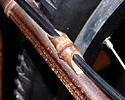
|
Anyway, Calfee apparently likes the stuff so much that on display at this year’s Interbike was another bamboo and carbon fiber frame, but this time it was a tandem! Not only was it a tandem, but it was a mountain bike tandem with a custom-built bamboo and carbon fiber dual-crown fork complete with spliced-on Maverick quick-release through-axle dropouts and truss-style carbon fiber upper crown, a Rohloff Speedhub 14-speed internally geared rear hub, dual disc brakes, and a host of other cool little details. Craig and his wife allegedly really ride the thing regularly, too.
Coolest gadget
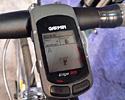
|
Global positioning satellite (GPS) systems are all the rage in electronics these days in a wide range of consumer markets. To date, though, the technology hasn’t hit the cycling community too hard but that may change with Garmin’s new Edge line of cycle computers. Both the 205 and 305 calculate your speed and distance without using wheel sensors of any sort or even any calibration. Hook it up and let the satellites figure it out. Heart rate and cadence functions are available as well.
The true coolness of this thing doesn’t really show itself, though, until you start playing with the computer functions and software. The large LCD displays a bunch of info, but also can draw you a little map of your current journey. If you’ve done a particular ride before and have it stored, you can even “race” against yourself on the screen!
Uploading your ride to your computer allows you to mate your ride data with Garmin’s MotionBased software which pairs your route with various topological and satellite image maps for a true record of what you did. They’re not cheap at nearly $400 for the top model, but I can’t think of another cycle computer that offers this level of functionality is this elegant of a package. Gimme.
Most potential
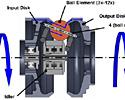
|
Fallbrook Technologies is not a brand name that most people will associate with cycling, but their NuVinci Compound Variable Planetary (CVP) drivetrain might just change that perception a bit in the coming years. Internally-geared hubs aren’t a new concept, but even the best ones currently on the market still have a significant amount of internal friction and a finite number of gear ratios. How’s it work, you ask? In summary, a set of rotating balls is positioned in between a rotating “input” ring and “output” ring. Adjusting the axis of rotation of the balls dictates how fast the output ring rotates relative to the input. It’s actually much more complicated in words than in pictures, and NuVinci’s web site explains the idea in a pictorial fashion quite nicely. The result is a seamless 400% “gear” ratio range and a vastly simplified internal system as compared to conventional planetary gear arrangements, making for more efficient power transmission and the option to truly shift at a standstill or under full power.
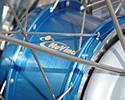
|
NuVinci isn’t even out on the market yet, but they’re targeting the recreational riders first since the system is allegedly so easy and intuitive to use, even for beginners who would normally balk at the army of shift levers that currently reside on most bikes. Okay, big deal, but what makes the system so significant is what impact it could have on the high-performance MTB market. I am personally already a proponent of the “transmission-in-a-box” concepts such as Hayes’ new transmission and Rohloff’s SpeedHub and associated G-Boxx standard as they greatly free up rear suspension design constraints and minimize the pitfalls of having exposed componentry hanging in mid-air everywhere along with a chain that is constantly shifting position all over the place. This NuVinci stuff, however, has the potential to be more efficient and more durable than current systems while eliminating, or at least minimizing, their drawbacks in a package that could be much, much lighter. Keep an eye on these guys in the years to come.
Photography
For a thumbnail gallery of these images, click here
Images by James Huang/Cyclingnews
- Craig Calfee poses with his bamboo and carbon fiber wunder-tandem.
- Check out the custom-spliced Maverick 24mm quick-release thru-axle dropouts!
- This is easily the coolest upper fork “crown” in existence. The truss design maximizes structural integrity using a minimum amount of material.
- Rear disc mount is neatly integrated into the rear dropout. The Rohloff Speedhub has been around for ages, but is still one of the only truly viable (and commercially available) alternatives to a conventional drivetrain.
- Miter a few bamboo tubes , wrap with some carbon, and “voila!”, you’ve got yourself a killer showpiece that actually works. Check out how the rear brake cable is routed.
- Tons of neat details adorn this tandem, including this slick housing guide.
- Just in case having bamboo in the frame weren’t enough…
- Ok, so these aren’t bamboo , but they’re still wood and carbon fiber!
- Clearly not one to be satisfied with off-the-shelf items, Craig Calfee even made his own wedding band out of a sample of superfine carbon fiber he had wrapped around a titanium core.
- Having one of these mounted to your stem is like having an aerial view of yourself riding in a video game. This is only one of several optional display screens (which are, thankfully, very intuitively laid out) but is arguably the coolest one as it draws a little map for you as you go.
Images by Garmin
- Optional heart rate monitor and cadence sensor integrate nearly all of your key functions in one little case. About the only thing it’s missing is a power meter… and a fountain Sprite machine.
- Garmin’s new Edge computer packs a wealth of features into a package barely wider than your stem. Speaking of which, the well-designed mount is stem and bar compatible.
Images by Fallbrook Technologies
- The input ring on the left is what would be directly driven by the rear cog. Power is transferred through a number of ball bearings (which could be ceramic someday…) to the output ring which drives the hub shell. Altering the axis of rotation of the ball bearings by adjusting the idler position varies the speed of the two rings relative to each other. The entire internal mechanism would be bathed in oil and, in theory, there would be virtually no internal wear as a microscopically thin barrier of oil should prevent any parts from physically contacting each other.
- Picture this on your state-of-the-art all-mountain rig someday, centrally located with a super clean chainline and no external transmission components… mmmm….